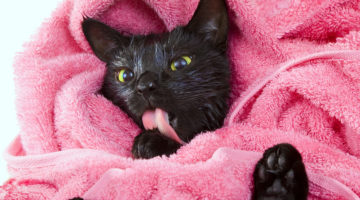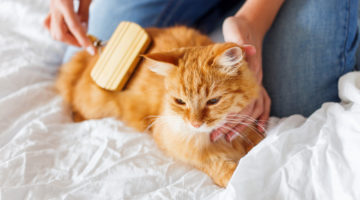Before you reach for the chemicals, give these more natural flea remedies a try.
If your cat is scratching more than usual, chances are she has fleas. To double check, place her on a paper towel and comb through her fur. If you don’t see any fleas right away, you’ll see black specks that turn pinkish-red when hit with a drop of water — that’s flea excrement and the red color is blood from its host – your cat. Luckily, there are lots of things you can do to get rid of fleas without resorting to harsh chemicals that can harm your kitty. Let’s take a look at some alternative ways to nix your cat’s fleas.
Getting started
Begin by filling a cup with soapy water, dip your cat’s flea comb in it, and start combing through her fur, drowning any fleas you find. Be sure to use a gentle soap that won’t irritate your cat’s skin. Another option is an apple cider vinegar rinse used in conjunction with a mild shampoo.
Next, make a plan of attack, keeping in mind the four stages of a flea’s life cycle: eggs, larve, pupae, adult. According to everydayroots.com, these stages break down as follows: 50% eggs, 35% larvae, 10% pupae, 5% adults. In other words, that flea you see burrowing in your cat’s fur is just the tip of the iceberg, so treatment must combat all life stages of the flea, and include not only the cat, but both the indoor and outdoor environment. And with spring on the doorstep, this is the time to start.
Focus on her overall health
The simplest step you can take to help combat fleas is to concentrate on the overall health of your cat by feeding her a high quality, additive-free, species-appropriate diet. Cats are obligate carnivores and require a whole meat-based diet for optimum health. Veterinarian Dr. Jean Hofve suggests supplementing with antioxidants and Omega 3 fatty acids. A healthy cat with a good immune system is less likely to develop skin problems when afflicted with fleas.

Non-toxic flea control methods
When dealing with the fleas themselves, veterinarian Dr. Richard Pitcairn recommends starting with the least toxic and least invasive methods of control.
Here are some excellent strategies:
- Wash all bedding in hot water.
- Vacuum thoroughly, and do it every day during peak infestation — carpeting and upholstered furniture are perfect incubators for flea eggs and larvae. Pay attention to cracks and crevices where the floors meet the walls. Discard the vacuum bag – outside the house – when you’re done.
- Try a soapy water flea trap – a bowl of dish soap under a nightlight. Check and replace as needed.
- Diatomaceous earth can be dusted in hard-to-reach interior locations, and outside around the foundation of the house. It works by slicing the exoskeleton of the flea, causing death by dehydration. Use food grade diatomaceous earth, and avoid inhalation.
- Beneficial nematodes can be deployed around the foundation of the house where they can feast on flea larvae. Be sure to use a product marketed for flea and pest control in gardens. Dr. Hofve adds that ladybugs and praying mantises should also be encouraged.
- Keep in mind that indoor cats are less likely to get fleas because they aren’t coming into contact with other animals. If your cat likes spending time outside, try to keep her confined to your yard with a cat enclosure, or by training her to walk on a harness.
Getting rid of your cat’s fleas entails a holistic approach that takes everything from her diet to her environment into consideration. With persistence, it pays off!







No Comment